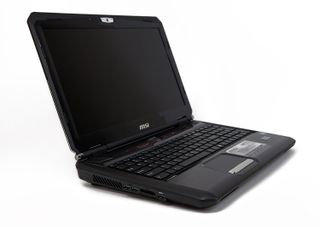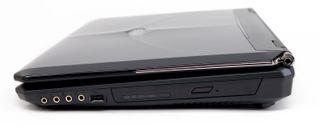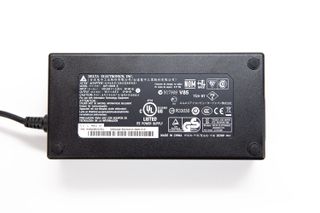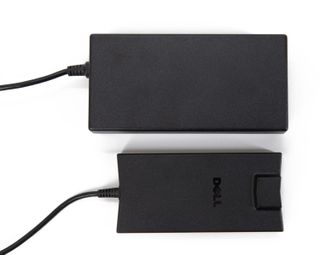MSI GX60 Review: Radeon HD 7970M In A $1,200 Notebook!
MSI's GX60-series notebook is in our lab today. Armed with Radeon HD 7970M graphics, a 15.6" display, and triple-screen output, this is truly a desktop replacement. But can its AMD A10-4600M APU keep pace with gaming platforms armed with Intel CPUs?
Exterior: Design And Features

The GX60's exterior design makes it seem like each major assembly was handled by separate groups without a lot of coordination between themselves. The lid is glossy and beveled, with a touch of very fine sparkle and a large inset MSI logo that lights up a bright white when the screen is on. The rear end of the lid features a textured surface that feels like rubber. The entire bottom of the chassis is built with a matte finish and texture. The buttons above the keyboard are surrounded by glossy red and black plastic, with a large silver power button in the middle and speakers flanking each side. The palm rest has a brushed steel texture, while the keyboard is flanked by smooth matte plastic on both sides. The screen bezel is a mix of glossy plastic around the screen, with an outer framing of matte plastic. Screen hinges are matte black with silver caps. Silver streaks run down half of each side of the lid.

Somehow, the GX60’s overall aesthetic grows on you, though. It’s very thick, with large vents on the side and back. Punches of silver and red convey a sense of style that has no idea what subtlety is. The GX60 is for people who want to game. Those who place performance before all else. Some of the design inconsistencies are probably a result of MSI attempting to build a frugally-priced machine with top-shelf parts. If the lid had been the same brushed steel finish as the palm rest, that would have tightened up the overall look of the machine, although it may have also contributed to higher costs. Mixing finishes and being unashamed of ports and vents filling every side of the machine is indicative of the GX60’s performance-oriented nature.

On the right side of the GX60, we have (from left to right) jacks for headphone out, microphone in, line in and line out, a USB 2.0 port, and the Blu-ray drive.

On the back of the machine, you have (again, from left to right) a Kensington lock, power plug, an Ethernet jack, VGA, mini-DisplayPort, and HDMI.

On the left side, from left to right, we see two USB 3.0 ports and an SD card reader (SDHC/SDXC/MMC), followed by another USB 3.0 port.

Opening up the lid, the GX60’s layout is fairly straightforward. The SteelSeries keyboard with number pad and the trackpad take up most of the space. Along the top of the keyboard lies a strip of custom controls and indicators. Smack in the center of the control strip is the large silver power button, while speakers are positioned at the far corners. There's a 720p webcam embedded in the middle of the screen's upper bezel, surrounded by a silver inset. Stereo mics are placed just to the left of the webcam.

On the bottom of the machine, we have a design clearly built for gaming. The rubber feet are absolutely massive for a notebook. There are vents everywhere, and the overall shape is shelved to give the CPU and GPU plenty of room to breathe. In fact, you can see the hard drive, SSDs, CPU, GPU, and RAM just by peering through the vents. If you can see those components, you know they're getting outside air to help them stay cool. That fan-like circle at the very top of the picture is actually the integrated subwoofer.
Stay on the Cutting Edge
Join the experts who read Tom's Hardware for the inside track on enthusiast PC tech news — and have for over 25 years. We'll send breaking news and in-depth reviews of CPUs, GPUs, AI, maker hardware and more straight to your inbox.

The 87 Wh battery has a latch and lock to keep it from accidentally being removed. For a battery with 87 Wh of capacity, it's smaller and lighter than we were expecting.

The included Delta Electronics 180 W AC Adapter, on the other hand, is quite massive.

Compared to the 90 W adapter from an office-oriented notebook, the GX60’s is quite large.

However, the 180 W adapter is exactly what gamers want to see. It uses a standard PC power cord, is chunky enough to deliver full power, and has the surface area to dissipate heat. This is a standard Delta Electronics unit used in many machines. If non-gamer friends scoff, go online and show them what a 300 W adapter looks like. Now that’s a knife!
Overall, the MSI GX60 may be a little mismatched, but its piece work well together. The little strip of rubberized coating on the back of the lid makes the machine easy to grip when closed. The palm rest has a mix of finishes, but it has a full-sized keyboard with number pad, direct controls for system modes, and a pretty decent trackpad (as far as trackpads go). Everything below the palm rest is solid and cohesive, with plenty of ports, output options, and massive cooling capability. All-in-all, the MSI GX60 is a solidly-constructed machine. A little thick, and not always well-coordinated, but then again, those qualities also describe some of our favorite gamers.
Current page: Exterior: Design And Features
Prev Page MSI GX60: Portable Power On A Budget Next Page Interior: Teardown Images And Components-
yobobjm I own an MSI (with some weird number classification that I can't remember) but it has proved to be a dedicated and powerful gaming laptop. It also has had really no problems other than the glossy finish getting scratched (which doesn't even exist on this laptop) so I would recommend MSI products :DReply -
flowingbass I also own an MSI, a GX660r with a 5870M and a Core i5 480m. The 5870M desktop equivalent is a HD5770. The GPU is quite struggling to play on high in current games, mid-high or sometimes medium (all low on crysis 3 except resolution and textures) is required to maintain playable frame rates.Reply
I might just upgrade to this and just swap GPU between the two. i5 480m > A10-4600M -
acktionhank Hey Tom's run a few gaming tests again with PScheck forcing the CPU to run at a 2.5-2.7ghz so that it won't throttle itself so much.Reply
I'd like to see exactly what speeds we'd need to get an A10-4600 running at to reduce these severe bottlenecks. -
silverblue Very nice machine. It's a shame that AMD stopped with the A10-4600M and didn't look to produce a higher model as that'd help, however until the HSA initiative really kicks in, the Bulldozer architecture's FPU implementation is always going to be found wanting, and that's without even talking about the sharing issues which Steamroller looks to fix.Reply
Most Popular

